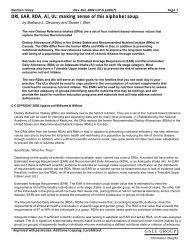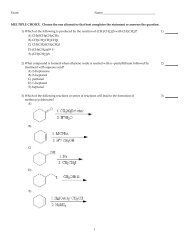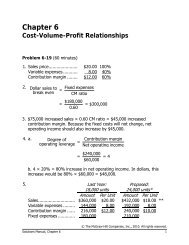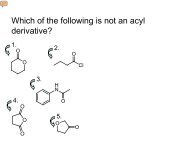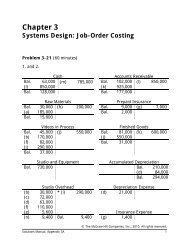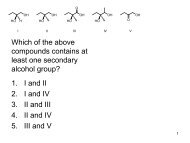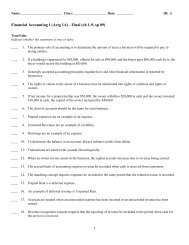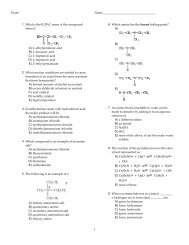CHAPTER 9 Inventories: Additional Valuation Issues - Fgamedia.org
CHAPTER 9 Inventories: Additional Valuation Issues - Fgamedia.org
CHAPTER 9 Inventories: Additional Valuation Issues - Fgamedia.org
Create successful ePaper yourself
Turn your PDF publications into a flip-book with our unique Google optimized e-Paper software.
<strong>CHAPTER</strong> 9<strong>Inventories</strong>: <strong>Additional</strong> <strong>Valuation</strong> <strong>Issues</strong>4 Sections in this document:A. Learning ObjectivesB. Chapter ReviewC. Lecture OutlineD. Illustrations (attached below)Note: the exhibits at the bottom of this document are only viewable in the pdf version of this file: [pdf version]A. LEARNING OBJECTIVES1. Describe and apply the lower-of-cost-or-market rule.2. Explain when companies value inventories at net realizable value.3. Explain when companies use the relative sales value method to value inventories.4. Discuss accounting issues related to purchase commitments.5. Determine ending inventory by applying the gross profit method.6. Determine ending inventory by applying the retail inventory method.7. Explain how to report and analyze inventory.*8. Determine ending inventory by applying the LIFO retail methods.*This material is covered in an Appendix to the chapter.top9-
B. <strong>CHAPTER</strong> REVIEW1. Chapter 9 concludes the discussion of inventories by addressing certain unique valuationproblems not covered in Chapter 8. Chapter 9 also includes a description of thedevelopment and use of various estimation techniques used to value ending inventorywithout a physical count.Lower of Cost or Market2. (S.O. 1) When the future revenue-producing ability associated with inventory is belowits original cost, the inventory should be written down to reflect this loss. Thus, thehistorical cost principle is abandoned when the future utility of the asset is no longer asgreat as its original cost. This is known as the lower-of-cost-or-market (LCM) method ofvaluing inventory and is an accepted accounting practice. When inventory declines invalue below its original cost, the inventory should be written down to reflect the loss. Thisloss of utility in inventory should be charged against revenue in the period in which theloss occurs.3. The term “market” in lower of cost or market generally refers to the replacement cost ofan inventory item. However, market value should not exceed net realizable value (NRV),nor should it be less than net realizable value less a normal markup. These are knownas the upper (ceiling) and lower (floor) limits of market, respectively. Market is defined asreplacement cost if such cost falls between the upper and lower limits. Should replacementcost be above the upper limit, market would be defined as net realizable value. If replacementcost falls below the lower limit, market is defined as net realizable value less a normalmarkup.*Note: All asterisked (*) items relate to material contained in the Appendix to the chapter.4. For example, consider the following illustration.Inventory at sales value $800Less: Cost to complete and sell 200Net realizable value (NRV) 600Less: Normal markup 100NRV less normal markup $500To arrive at the final inventory valuation, market value must be determined and thencompared to cost. Market value is determined by comparing replacement cost of theinventory with the upper and lower limits. If replacement cost of the inventory in theexample is $550, then $550 is compared to cost in determining lower of cost or marketbecause replacement cost falls between the upper ($600) and lower ($500) limits. Ifreplacement cost of the inventory is $650, it would exceed the upper limit; thus the upperlimit ($600) would be compared to cost in determining lower of cost or market. Similarly, ifreplacement cost of the inventory is $450, it would be lower than the lower limit and thusthe lower limit ($500) would be compared to cost in determining lower of cost or market.The amount that is compared to cost, often referred to as designated market value, isalways the middle value of the three amounts: replacement cost, net realizable value, andnet realizable value less a normal profit margin.9-
top5.The cost or market rule may be applied (a) directly to each item, (b) to each category, or (c)to the total inventory. The individual-item approach is preferred by many companiesbecause tax rules require its use when practical, and it produces the most conservativeinventory valuation on the balance sheet. When inventory is written down to market, thisnew basis is considered to be the cost basis for future periods. The method selectedshould be the one that most clearly reflects income.Direct vs. Allowance Method6. Two methods are used to record inventory at market. The two methods are the directmethod and the indirect or allowance method. The direct method substitutes themarket value figure for cost when valuing the inventory. Thus, the loss is buried in thecost of goods sold and no individual loss account is reported in the income statement.Under the indirect method, an entry is made debiting a loss and crediting an allowanceaccount for the difference between cost and market. Separately recording the loss anda contra account is preferable as it does not distort the cost of goods sold and clearlydisplays the loss from market decline.7. (S.O. 2) Recording inventory at selling price less estimated cost to complete and sell (netrealizable value) is acceptable in certain instances. To be accorded this treatment, theitem should (a) have a controlled market with a quoted price applicable to all quantitiesand (b) have no significant disposal costs. Certain minerals sold in a controlled marketand agricultural products that are marketable at fixed prices provide examples of inventoryitems carried at selling price.8. (S.O. 3) When a group of varying inventory items is purchased for a lump sum price,a problem exists relative to the cost per item. The relative sales value method apportionsthe total cost to individual items on the basis of the selling price of each item.Purchase Commitments9. (S.O. 4) Purchase commitments represent contracts for the purchase of inventory ata specified price in a future period. If material, the details of the contract should be disclosedin a note of the buyer’s balance sheet. If the contract price is in excess of the market priceand it is expected that losses will occur when the purchase is effected, the loss should berecognized in the period during which the market decline took place.topThe Gross Profit Method10. (S.O. 5) The gross profit method is used to estimate the amount of ending inventory. Itsuse is not appropriate for financial reporting purposes; however, it can serve a usefulpurpose when an approximation of ending inventory is needed. Such approximations aresometimes required by auditors or when inventory and inventory records are destroyedby fire or some other catastrophe. The gross profit method should never be used asa substitute for a yearly physical inventory unless the inventory has been destroyed. The9-
gross profit method is based on the assumptions that (a) the beginning inventory pluspurchases equal total goods to be accounted for; (b) goods not sold must be on hand;and (c) if sales, reduced to cost, are deducted from the sum of the opening inventory pluspurchases, the result is the ending inventory.The Retail Inventory Method11. (S.O. 6) The retail inventory method is an inventory estimation technique based uponan observable pattern between cost and sales price that exists in most retail concerns.This method requires that a record be kept of (a) the total cost and retail of goodspurchased, (b) the total cost and retail value of the goods available for sale, and (c) the salesfor the period.12. Basically, the retail method requires the computation of the cost-to-retail ratio of inventoryavailable for sale. This ratio is computed by dividing the cost of the goods available forsale by the retail value (selling price) of goods available for sale. Once the ratio isdetermined, total sales for the period are deducted from the retail value of inventoryavailable for sale. The resulting amount represents ending inventory priced at retail.When this amount is multiplied by the cost to retail ratio, an approximation of the cost ofending inventory results. Use of this method eliminates the need for a physical count ofinventory each time an income statement is prepared. However, physical counts aremade at least yearly to determine the accuracy of the records and to avoid overstatementsdue to theft, loss, and breakage.13. To obtain the appropriate inventory figures under the retail inventory method, propertreatment must be given to markups, markup cancellations, markdowns, and markdowncancellations.14. When the cost to retail ratio is computed after net markups (markups less markupcancellations) have been added, the retail inventory method approximates lower of costor market. This is known as the conventional retail inventory method. If both netmarkups and net markdowns are included before the cost to retail ratio is computed, theretail inventory method approximates cost.15. The retail inventory method becomes more complicated when such items as freight-in,purchase returns and allowances, and purchase discounts are involved. In essence,the treatment of the items affecting the cost column of the retail inventory approachfollows the computation of cost of goods available for sale. Freight costs are treated asa part of the purchase cost; purchase returns and allowances are ordinarily considereda reduction of the price at both cost and retail; and purchase discounts usually areconsidered as a reduction of the cost of purchases.top16. Other items that require careful consideration include transfers-in, normal shortages,abnormal shortages, and employee discounts. Transfers-in from another departmentshould be reported in the same way as purchases from an outside enterprise. Normalshortages should reduce the retail column because these goods are no longer availablefor sale. Abnormal shortages should be deducted from both the cost and retail columns9-
and reported as a special inventory amount or as a loss. Employee discounts should bededucted from the retail column in the same way as sales.17. The retail inventory method is widely used (a) to permit the computation of net income withouta physical count of inventory, (b) as a control measure in determining inventory shortages,(c) in regulating quantities of inventory on hand, and (d) for insurance information. Theadvantages and disadvantages of the lower-of-cost-or-market method (conventional retail)versus LIFO retail are the same as for nonretail operations. In the final analysis, theultimate decision concerning which retail inventory method to use is often based on themethod that results in the lower taxable income.Presentation and Analysis18. <strong>Inventories</strong> normally represent one of the most significant assets held by a businessentity. Therefore, the accounting profession has mandated certain disclosure requirementsrelated to inventories. Some of the disclosure requirements include: the composition ofthe inventory, the inventory financing, the inventory costing methods employed, andwhether costing methods have been consistently applied. Currently, there is a great dealof interest in the effects of inflation on inventory holdings. Two common financial ratiosused to analyze inventory are (1) the inventory turnover ratio and (2) the average days tosell inventory.LIFO Retail*19. Many accountants suggest a LIFO assumption be adopted for use with the application ofthe retail inventory method. Use of LIFO in connection with the retail inventory method isthought to result in a better matching of costs and revenues. The application of LIFOretail is made under two assumptions (a) stable prices, and (b) fluctuating prices.Because the LIFO method is a cost method, not a cost or market approach, both themarkups and markdowns must be considered in obtaining the proper cost to retailpercentage. Beginning inventory is excluded from the computation of the cost to retailpercentage because of the layer effect that results from the use of the LIFO method.*20. If changes in the price level occur, the effect of such changes must be eliminated whenusing the LIFO retail method. If an enterprise wishes to change from conventional retail toLIFO retail, the beginning inventory must be restated to conform with the LIFO assumption.In effecting the change, the inventory of the prior period must be recomputed on the LIFObasis. This amount then serves as the beginning inventory for the LIFO retail methodapplied in the current period.top9-
C. LECTURE OUTLINEThis chapter describes inventory valuation problems and estimation techniques. Appendix 9-Adescribes the application of the LIFO retail method under two assumptions: (1) stable pricesand (2) fluctuating prices.Most of you are aware of the LCM valuation rule for inventory but have not dealt with theceiling and floor constraints. Similarly, many of you have been exposed to a retail inventorymethod (usually the conventional retail method) but have no experience with LIFO retail, andare unfamiliar with such complications as markups, markdowns, employee discounts, normaland abnormal spoilage, etc.Chapter 9 inventory techniques do not represent complete departures from the FIFO, LIFO,and average cost bases of valuing inventory. For example, the LCM rule results in inventorybeing stated at the “lower of FIFO cost or market,” or “lower of average cost or market,” etc.Similarly, the retail method can be adapted to approximate any of the major cost flowassumptions: FIFO, LIFO, or average cost.The following lecture outline is appropriate for this chapter.A. (L.O. 1) Lower of Cost or Market (LCM).1. The general rule is that the historical cost principle is abandoned when the future utilityof the asset is no longer as great as its original cost.2. The term “market” in the LCM rule means the cost to replace the item by purchase orreproduction. This is a measurement of entry value.a. The market amount is limited by ceiling and floor restrictions that are based onmeasurements of exit value.(1) The ceiling is equal to net realizable value: estimated selling price lessestimated disposal cost.(2) The floor is equal to the ceiling less normal profit margin.b. Point out the reasons for this lower of cost or “constrained market” rule:top(1) A decline in the selling price of an item is not always accompanied by a decline incost. That is, entry values do not always respond immediately and proportionatelyto changes in exit values.(2) If an item has not lost its revenue-producing power, a writedown to replacementcost in the current period would understate current income and overstateincome in the period of sale.9-
3. Describe the two-step computational approach to LCM valuation:Attached BelowIllustration 9-1 shows the lower of cost or market technique. The 2-step approach isdemonstrated for two different examples.a. First find the designated “market” figure: This is the middle value of replacementcost, the ceiling, and the floor.b. Then find the lower of historical cost or “designated market.”4. The LCM rule may be applied either (a) directly to each item or (b) to the total of theinventory or (c) in some cases, to the total of the components of each major category.As soon as the inventory is written down to market, the new basis is considered to bethe cost basis for future periods.5. Recording market declines in inventory. Two possibilities:a. Direct method—Show the inventory at market in both the balance sheet and thecost of goods sold section of the income statement. The disadvantage is that themarket decline is buried in the cost of goods sold figure.b. Indirect or Allowance method—Record the market decline with a debit to a lossaccount and a credit to an allowance account which is deducted from Inventory onthe balance sheet. The allowance account must be adjusted each period.top6. The conceptual deficiencies of the LCM rule include:a. Inconsistent treatment of recognizing a loss in the period when inventory valuesdecrease but delaying inventory value increases until the period when inventory is sold.b. Application of the rule results in inconsistency because the inventory may be valuedat cost in one year and at market in the next year.c. LCM inventory valuation results in a conservative inventory value on the balancesheet but it may have the opposite effect on the income statement in subsequentperiods if expected sales price declines do not materialize.d. Subjectivity in calculating a “normal profit” that may present opportunities for incomemanipulation.B. Other <strong>Valuation</strong> Bases.1. (L.O. 2) <strong>Valuation</strong> at net realizable value—Certain goods (such as minerals andagricultural products) that are sold in a controlled market with a quoted price9-
applicable to all quantities and with no significant disposal costs may be reported atnet realizable value.2. (L.O. 3) <strong>Valuation</strong> using the relative sales value method—When several differentassets are acquired in a lump-sum purchase the joint cost can be allocated on thebasis of relative sales value.For example, suppose that two assets are acquired for $1,000. Asset 1 has a sellingprice of $700 and Asset 2 has a selling price of $800.$700Allocated cost of Asset 1 =$1,500 x $1,000 = $467.$800Allocated cost of Asset 2 =$1,500 x $1,000 = $533.topC. (L.O. 4) Purchase Commitments.1. Accounting for ordinary purchase orders which are subject to cancellation by thebuyer or seller: These do not represent either an asset or a liability to the buyer. Theyare not recorded or reported in the financial statements.2. Accounting for formal purchase orders for which a firm price has been established:a. If the market price exceeds the contracted price—disclose the existence of thecontract in the notes, if material.b. If the market price is less than the contracted price—(1) Debit a loss account and credit a liability account (Estimated Loss on PurchaseCommitments).(2) Eliminate the liability account when the inventory is acquired. Record anyadditional price decline as an additional loss. Record any price recovery (upto the contract price) as a gain (Recovery of Loss). Point out that as a resultof this procedure:(a) The loss is recorded in the period of price decline rather than in the periodof acquisition.(b) The inventory is entered on the books at the lower of contract price ormarket as of the date of acquisition.3. Accounting for purchase commitments (and other executory contracts) is controversial.Discuss the logic of recording a loss and a liability on assets that have not yet beenacquired. To whom is such a liability owed?9-
top9-
D. (L.O. 5) The Gross Profit Method.1. This method is used when an estimate of a firm’s inventory is required. The resultingestimate is acceptable for interim reporting purposes but not generally for annualreporting.2. Four items of information are sufficient to estimate the cost of ending inventory:a. Cost of beginning inventory.b. Cost of purchases for the period.c. Sales during the period.d. Markup, expressed either as a percentage of cost or as a percentage of sales.3. In this context the terms “gross margin,” “gross profit,” and “markup” are synonymous.Discuss the distinction between markup expressed as a percentage of cost andmarkup expressed as a percentage of sales. Describe how the percentage markup iscomputed.For example, an item that costs $60 and is sold for $75 has a gross profit or markup of $15.Markup as a Percentage of Sales=MarkupSelling Price =$15$75 = 20%.Markup as a Percentage of CostMarkup$15top=Cost =$60 = 25%.4. Describe how to convert a markup on cost to a markup on sales.a. From markup cost to markup on sales.markup on cost1+ markup on cost = markup on salesb. From markup sales to markup on cost.markup on sales1– markup on sales = markup on cost9-
Attached BelowReview the steps in solving gross profit problems as demonstrated by the example inIllustration 9-2.5. Appraisal of the gross profit method.a. It provides an estimate based on past percentages.b. Use of a blanket gross profit rate is not appropriate when a company handlesdifferent lines of merchandise with widely varying rates of gross margin.topE. (L.O. 6) The Retail Inventory Method.Attached BelowThe gross profit and conventional retail methods are demonstrated with the numericalexample given in Illustration 9-3.1. Like the gross profit method, the retail method provides an estimate of ending inventory.Unlike the gross profit method, the retail method produces estimates that may beacceptable for financial statement purposes.2. More detailed records are required for the retail method than for the gross profitmethod. Under the retail method, records must be kept of the following.a. Beginning inventory at cost and at retail.b. Purchases for the period at cost and at retail.c. Sales during the period at retail.d. The cost and/or retail amounts of special items such as markups, markdowns,employee discounts, spoilage, etc. Discuss the meaning of each of these items.3. Variations of the retail method:a. The retail method can be adapted for use with:(1) any of the major inventory cost flow assumptions: FIFO, LIFO, or Average.(2) either of the inventory valuation methods: cost or LCM.(3) either of the LIFO approaches: stable prices (unit LIFO) or fluctuating prices(dollar-value LIFO). Discussed in Appendix 9-A.9-
. Therefore several variations are possible, although not all of the possible combinationsare in accordance with GAAP (i.e., LIFO should be reported at cost and not at LCM).The textbook illustrates three of the possible variations:(1) Average at LCM (conventional retail).(2) LIFO at cost with stable prices (LIFO retail). Discussed in Appendix 9-A.top(3) LIFO at cost with fluctuating prices (dollar-value LIFO retail). Discussed inAppendix 9-A.4. There are three basic steps in computing all retail inventory problems:a. Compute ending inventory at retail. This step is the same regardless of whichvariation (LIFO cost or average LCM, etc.) is used. The Feminine ExecutiveApparel illustration on text page 440 provides a good example of the major items(normal and abnormal shortage, employee discounts, etc.) which may arise in thecomputation of ending inventory at retail.b. Compute the cost-to-retail ratio. This step will vary depending on which variationof the retail method is used. The following formulas may be used:(1) Conventional retail (average LCM) ratio =AtCostBeginningInventory + Purchases –AtRetailBeginningInventory + Purchases –MarkupsPurchase Returns,AbnormalAllowances, Discounts + Freight-in – SpoilagePurchase Returns,Allowances, Discounts –AbnormalSpoilage + NettopF. (L.O. 7) Financial Statement Presentation of <strong>Inventories</strong>. The following items must be disclosed:1. The composition of manufactured inventory (raw materials, work in process, and finishedgoods).2. Unusual or significant financing arrangements including related party transactions, firmpurchase commitments, involuntary LIFO liquidation, etc.3. The inventory costing methods used.4. The consistency of costing methods from one period to another.5. Supplementary price-level information is voluntary.9-
G. (L.O. 8) APPENDIX 9-A. LIFO Retail Methods.Attached BelowIllustration 9-4 demonstrates the LIFO retail method using both stable and fluctuatingprices.1. The methods are:a. LIFO retail (LIFO at cost with stable prices).b. Dollar-value LIFO retail (LIFO at cost with fluctuating prices).2. Emphasize the following when teaching the two LIFO retail approaches:a. The beginning inventory cost and retail data are excluded from computation ofthe cost-to-retail ratio.b. Both net markups and net markdowns are considered in obtaining the cost-toretailratio.c. It is assumed that the markups and markdowns apply only to the goods purchasedduring the current period and not to the beginning inventory.d. The LIFO computation proceeds by separate layers for each year.3. The three basic steps in computing the cost of ending inventory using LIFO retailmethods are:a. Compute ending inventory at retail.b. Compute the cost-to-retail ratio.(1) LIFO retail stable or fluctuating prices) ratio =AtCost Purchases –AtRetail Purchases –Purchase Returns,AbnormalAllowances, Discounts + Freight-in – SpoilagePurchase Returns, AbnormalAllowances, Discounts – Spoilage + Net Markups –NetMarkdownstopc. Apply the cost-to-retail ratio to the ending inventory at retail to obtain the endinginventory at LIFO cost.9-
(1) LIFO retail (stable prices): The computation proceeds by separate layersfor each year.(a) When ending inventory at retail is larger than beginning inventory at retail,an inventory layer has been added.1) Subtract the beginning inventory at retail and write the beginninginventory at cost.2) Multiply the current cost-to-retail ratio by the new layer at retail toobtain the inventory increase at cost.3) Add 1) and 2) to obtain the ending inventory at LIFO cost.(b) When ending inventory at retail is less than beginning inventory at retail,a portion of the beginning layers has been liquidated. Previous layersmust be reduced in a LIFO flow starting with the last layer added.(2) Dollar-value LIFO retail (fluctuating prices):The computation proceeds by separate layers for each year.(a) Use the current price index to deflate the ending inventory at retail to theending inventory at base-year retail prices.(b) Separate the ending inventory at base-year prices [from step (a)] intolayers for each year.(c) For each layer from step (b), multiply the amount by the appropriate costto-retailratio and by the appropriate price index to obtain the amount ofeach layer at LIFO cost.(d) Add each layer from step (c) to obtain the total ending inventory at LIFOcost. Any decrease in inventory layers is “peeled off” at prices inexistence when the layers were previously added.Attached BelowThe relationship between the dollar-value and retail LIFO methods are shown withIllustrations 9-5. This example illustrates the use of the methods over five periods andincludes an inventory decrease in one period.Illustration 9-6 contains the 1953 AICPA statements related to inventory valuation.4. Appraisal of the Retail Inventory Method.a. The method permits:(1) the computation of net income without a physical count of inventory.(2) a control measure in determining inventory shortages.(3) regulation of quantities of merchandise on hand.9-
(4) a basis for information needed for insurance purposes.topb. The method has an averaging effect on varying rates of gross margin. Problemsmay arise when the averages being used are not reflective of underlying conditions.9-
D. ILLUSTRATIONSILLUSTRATION 9-1LCM INVENTORY VALUATIONAPPLICATION OF LOWER OF COST OR MARKETCEILINGCOSTNet RealizableValue (NRV)ReplacementCostNRV—NormalProfit MarginFLOORSelect the Middle ValueSTEP 1:Determine theDesignatedMarket ValueDesignatedMarketValueSTEP2: Select the Lower of Cost or Designated Market ValueBalance Sheet Inventory ValueNET REALIZABLE VALUE (NRV) —estimated selling price less costs ofcompletion and disposal (covers obsolete, damaged and shopworn goods).NRV LESS NORMAL PROFIT MARGIN —generally measured as a percentage ofselling price (represents achievable gross profit even if replacement cost islower.)NRV prevents overstatement of inventory and understatement of current period loss;NRV—NPM prevents understatement of inventory and overstatement of current loss.9-
topILLUSTRATION 9-1 (continued)SITUATION ACOST$30NetRealizableValue$40ReplacementCost$35NRV LessNormal Profit$20MarketValue$35Balance Sheet Inventory Value = $30SITUATION BCOST$30NetRealizableValue$40ReplacementCost$18NRV LessNormal Profit$20MarketValue$20Balance Sheet Inventory Value = $209-
topILLUSTRATION 9-2THE GROSS PROFIT METHODTHE GROSS PROFIT METHODThere is one general approach to estimating the cost of ending inventory using thegross profit method. It makes use of the gross profits on sales. If given the markupon cost, compute the gross profit on sales.Assume that the following information is given:Beginning inventory $ 60,000Purchases 90,000Sales 100,000Markup on cost 25%You are to use the gross profit method to solve for the cost of ending inventory.1. Compute gross profit on sales (if not given):Gross profit on Sales =Markup on cost100% + Markup on cost= 25% = 25% = 20%100% + 25% 125%2. Compute cost of goods sold:Cost of Goods Sold = Sales × (100 % – Gross profit on Sales)= $100,000 × (100% – 20%)= $100,000 × 80%= $80,0003. Compute estimated cost of ending inventory:Cost of beginning inventory $ 60,000+ Cost of purchases 90,000Cost of goods available for sale 150,000– Cost of goods sold 80,000Estimated cost of ending inventory $ 70,0009-
topILLUSTRATION 9-3NUMERICAL EXAMPLE OF THE GROSS PROFITAND CONVENTIONAL RETAIL METHODSAssume that the following information is given:Beginning Inventory Net Sales at Retail $280,000At Cost $ 100,000 Average Cost per Unit $ 8.00At Retail 125,000 Average Selling Price per Unit $10.00Net PurchasesAt Cost $300,000At Retail 360,000Net Markups 15,000Net Markdowns 10,000GROSS PROFIT METHODGross Profit Percentage = $2/$10 = 20%Cost of goods sold = $280,000 × (100% – 20%) = $280,000 × 80%= $224,000Ending inventory = $100,000 + $300,000 – $224,000 = $176,000CONVENTIONAL RETAIL METHODEnding inventory at retail = $125,000 + $360,000 + $15,000 – $10,000 – $280,000= $210,000Cost-to-retail ratio = $100,000 + $300,000 =$125,000 + $360,000 + $15,000= 80%Ending inventory ataverage, LCM = 80% × $210,000 = $168,000$400,000$500,000top9-
ILLUSTRATION 9-4NUMERICAL EXAMPLE OF THE LIFO RETAIL METHODSAssume the following information is given:Beginning Inventory Net Sales at Retail $280,000At Cost $100,000 Price IndexAt Retail 125,000 Beginning 100Net Purchases Ending 105At Cost 300,000 Average Cost per Unit $8.00At Retail 360,000 Average Selling Price per Unit $10.00Net Markups 15,000Net Markdowns 10,000RETAIL LIFO (STABLE PRICES)Ending inventory at retail = $210,000 (see previous illustration).Cost-to-retail ratio = $300,000= $300,000 .$360,000 + $15,000 – $10,000 $365,000= 82.19%Ending inventory atLIFO cost= $169,862 (see below).Cost RetailEnding inventory $210,000Beginning inventory $100,000 125,000New layer $ 85,000At cost (82.19% × $85,000) 69,862Ending inventory at LIFO $169,862DOLLAR-VALUE LIFO RETAIL (FLUCTUATING PRICES)Ending inventory at retail = $210,000Cost-to-retail ratio = 82.19% (see above).Ending inventory at dollar-value LIFO = $164,725 (see below).Cost RetailEnding inventory deflated ($210,000 ÷ 1.05) $200,000Base layer $100,000 125,000New layer $ 75,000At cost (105% × 82.19% × $75,000) 64,725Ending inventory at dollar-value LIFO $164,7259-
topILLUSTRATION 9-5RELATIONSHIP BETWEEN LIFO RETAILAND DOLLAR-VALUE LIFOExhibit 1Dollar-Value LIFO DataYear 1 Year 2 Year 3 Year 4 Year 5(a) December 31 inventory priced at year-end(current) acquisition cost amounts $10,000 $10,920 $11,663 $11,880 $12,533(b) Price index (wholesale) (Year 1 is base year) 1.00 1.04 1.07 1.10 1.12(c) <strong>Inventories</strong> restated in base-year dollars(Line (a) ÷ line (b)) $10,000 $10,500 $10,900 $10,800 $11,200(d) Increments in base-year dollarsduring Year number +$500 +$400 –$100 +$4002 3 4 5Exhibit 2Retail LIFO DataYear 1 Year 2 Year 3 Year 4 Year 5(e) December 31 inventory priced at year-end(current) retail amounts $15,000 $16,068 $17,066 $17,172 $17,334(f) Price index (retail) (Year 1 is base year) 1.00 1.03 1.06 1.08 1.07(g) <strong>Inventories</strong> restated in base-year retail dollars(Line (e) ÷ line (f)) $15,000 $15,600 $16,100 $15,900 $16,200(h) Increments in base-year dollarsduring Year number +$600 +$500 –$100 +$3002 3 4 5(i) Percentage of cost to sales price .60 .62 .58 .61 .659-
topILLUSTRATION 9-5 (continued)LegendLayer:at base-yearat LIFO costIndexExhibit 3Diagrammatic Presentation of Dollar-Value LIFO:Data and Ending Inventory Calculations(Based on Exhibit 1 Data)Year 1 Year 2 Year 3 Year 4 Year 5$10,000$500 1.04$520$10,000$400 1.07$428$500 1.04$520$10,000$300 1.07$321$500 1.04$520$10,000$400 1.12$448$300 1.07$321$500 1.04$520$10,000 1.00 $10,000 1.00 $10,000 1.00 $10,000 1.00 $10,000 1.00$10,000Ending Inventory:(1) Stated at base-year dollars $10,000 $10,500 $10,900 $10,800 $11,200(2) Stated at Dollar-Value $10,000 $10,520 $10,948 $10,841 $11,289LIFOLayer: Indexbase-year %cost toLIFO cost SalesExhibit 4Diagrammatic Presentation of Retail LIFO:Data and Ending Inventory Calculations(Based on Exhibit 2 Data)Year 1 Year 2 Year 3 Year 4 Year 5$600 1.03$500 1.06$600 1.03$300 1.06$600 1.03$300 1.07$208.65 .65$300 1.06$307.40 .58 $184.44 .58 $184.44 .58$600 1.03$383.16 .62 $383.16 .62 $383.16 .62 $383.16 .62$15,000 1.00 $15,000 1.00 $15,000 1.00 $15,000 1.00 $15,000 1.00$ 9,000 .60 $ 9,000 .60 $ 9,000 .60 $ 9,000 .60 $ 9,000 .60Ending Inventory:(1) Stated at base-year Retail $15,000 $15,600.00 $16,100.00 $15,900.00 $16,200.00(2) Stated at Retail LIFO $ 9,000 $ 9,383.16 $ 9,690.56 $ 9,567.60 $ 9,776.25Source: A Jay Hirsch, "Dollar-Value and Retail LIFO: A Diagrammatic Approach," The Accounting Review, (October, 1969), pp. 840–8429-
topILLUSTRATION 9-6SUMMARY OF INVENTORY VALUATION STANDARDSIn 1953, the AICPA published in revised and rewritten final form tenstatements related to inventory valuation that today still represent thebasic accounting standards for the valuation and reporting ofinventories.These standards are quoted below:STATEMENT 1. The term inventory is used herein to designate theaggregate of those items of tangible personal property which (1) areheld for sale in the ordinary course of business, (2) are in process ofproduction for such sale, or (3) are to be currently consumed in theproduction of goods or services to be available for sale.STATEMENT 2. A major objective of accounting for inventories is theproper determination of income through the process of matchingappropriate costs against revenues.STATEMENT 3. The primary basis of accounting for inventories iscost, which has been defined generally as the price paid orconsideration given to acquire an asset. As applied to inventories,cost means in principle the sum of the applicable expenditures andcharges directly or indirectly incurred in bringing an article to itsexisting condition and location.STATEMENT 4. Cost for inventory purposes may be determinedunder any one of several assumptions as to the flow of cost factors(such as first-in first-out, average, and last-in first-out), the majorobjective in selecting a method should be to choose the one which,under the circumstances, most clearly reflects periodic income.STATEMENT 5. A departure from the cost basis of pricing theinventory is required when the utility of the goods is no longer asgreat as its cost. Where there is evidence that the utility of goods, intheir disposal in the ordinary course of business, will be less thancost, whether due to physical deterioration, obsolescence, changesin price levels, or other causes, the difference should be recognizedas a loss of the current period. This is generally accomplished bystating such goods at a lower level commonly designated as market.top9-
ILLUSTRATION 9-6 (continued)topSTATEMENT 6. As used in the phrase lower of cost or market*,the term market means current replacement cost (by purchase orby reproduction, as the case may be) except that: (1) marketshould not exceed the net realizable value (i.e., estimated sellingprice in the ordinary course of business less reasonablypredictable costs of completion and disposal); and (2) market shouldnot be less than net realizable value reduced by an allowance for anapproximately normal profit margin.STATEMENT 7. Depending on the character and composition ofthe inventory, the rule of cost or market, whichever is lower mayproperly be applied either directly to each item or to the total of theinventory (or, in some cases, to the total of the components of eachmajor category). The method should be that which most clearlyreflects periodic income.STATEMENT 8. The basis of stating inventories must beconsistently applied and should be disclosed in the financialstatements; whenever a significant change is made therein, thereshould be disclosure of the nature of the change and, if material,the effect on income.STATEMENT 9. Only in exceptional cases may inventories properlybe stated above cost. For example, precious metals having a fixedmonetary value with no substantial cost of marketing may be statedat such monetary value; any other exceptions must be justifiable byinability to determine appropriate approximate costs, immediatemarketability at quoted market price, and the characteristic of unitinterchangeability. Where goods are stated above costs, this factshould be fully disclosed.STATEMENT 10. Accrued net losses on firm purchase commitmentsfor goods, measured in the same way as are inventory losses, should,if material, be recognized in the accounts and the amounts thereofseparately disclosed in the income statement.*The terms cost or market, whichever is lower, and lower of cost or market are used synonymouslyin general practice. The committee does not express any preference for either of the twoalternatives.9-





